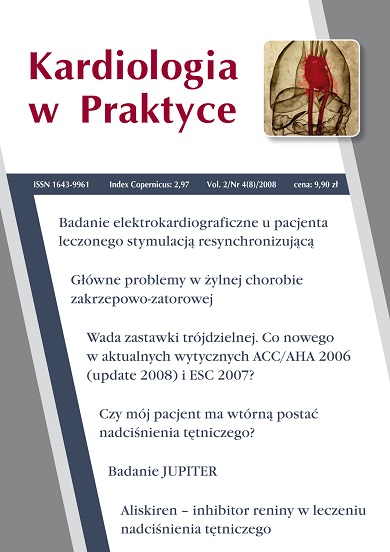Czy mój pacjent ma wtórną postać nadciśnienia tętniczego? Artykuł przeglądowy
##plugins.themes.bootstrap3.article.main##
Abstrakt
Nadciśnienie tętnicze to jedna z najczęstszych chorób w Polsce. Szacuje się, że dotyka ono około 8 mln Polaków. W tej liczbie około 95% przypadków nadciśnienia ma charakter pierwotny, jednak pozostałych 5% powstało na skutek różnych przyczyn. Spośród najczęstszych z nich należy wymienić: miąższowe choroby nerek, zwężenie tętnicy nerkowej, obturacyjny bezdech senny, pierwotny hiperaldosteronizm. Do rzadziej spotykanych przyczyn nadciśnienia należą: guz chromochłonny, nadczynność i niedoczynność tarczycy, koarktacja aorty, zespół Cushinga, przyjmowanie niektórych leków. Nadciśnienie wtórne można podejrzewać na podstawie wywiadu, badania fizykalnego, podstawowych badań laboratoryjnych. Charakterystyczne cechy, na które należy zwrócić uwagę, to: pojawienie się nadciśnienia w młodym lub późnym wieku, oporność na leczenie lub nagłe pogorszenie dotychczas prawidłowo kontrolowanego nadciśnienia. Ustalenie przyczyny pozwala bądź na całkowite wyleczenie nadciśnienia, bądź na jego skuteczniejszą kontrolę. Podstawowe badania sugerujące określoną patologię mogą być wykonane przez lekarza podstawowej opieki zdrowotnej, jednak dalsza diagnostyka możliwa jest jedynie w specjalistycznych ośrodkach.
Pobrania
##plugins.themes.bootstrap3.article.details##

Utwór dostępny jest na licencji Creative Commons Uznanie autorstwa – Użycie niekomercyjne – Bez utworów zależnych 4.0 Międzynarodowe.
Copyright: © Medical Education sp. z o.o. This is an Open Access article distributed under the terms of the Attribution-NonCommercial 4.0 International (CC BY-NC 4.0). License (https://creativecommons.org/licenses/by-nc/4.0/), allowing third parties to copy and redistribute the material in any medium or format and to remix, transform, and build upon the material, provided the original work is properly cited and states its license.
Address reprint requests to: Medical Education, Marcin Kuźma (marcin.kuzma@mededu.pl)
Bibliografia
2. Tykarski A., Posadzy-Małaczyńska A., Wyrzykowski B. et al.: Rozpowszechnienie nadciśnienia tętniczego oraz skuteczność jego leczenia u dorosłych mieszkańców naszego kraju. Wyniki programu WOBASZ. Kardiol. Pol. 2005, 63: S614-S619.
3. Zalecenia dotyczące diagnostyki i leczenia chorych z nadciśnieniem tętniczym spowodowanym zwężeniem tętnicy nerkowej (nadciśnieniem naczyniowo-nerkowym). Grupa Robocza Polskiego Towarzystwa Nadciśnienia Tętniczego. Nadciśnienie Tętnicze 2006, 6 (10): 489-500.
4. Kaplan N.M.: Nadciśnienie tętnicze-aspekty kliniczne. Wydawnictwo Czelej, Lublin 2006: 383-406.
5. Hirsch A.T., Haskal Z.J., Hertzer N.R. et al.: ACC/AHA 2005 practice guidelines for the management of patients with peripheral arterial disease (lower extremity, renal, mesenteric, and abdominal aortic): a collaborative report from the American Association for Vascular Surgery/Society for Vascular Surgery, Society for Cardiovascular Angiography and Interventions, Society for Vascular Medicine and Biology, Society of Interventional Radiology, and the ACC/AHA Task Force on Practice Guidelines (Writing Committee to Develop Guidelines for the Management of Patients With Peripheral Arterial Disease). J. Am. Coll. Cardiol. 2006, 47: 1239-312.
6. From The American College of Cardiology’s CardiosourceRenal Artery Intervention: Who Gets What and When? Posted 08/08/2008 Expert: Michael R. Jaff, D.O., F.A.C.C., Interviewer: C. Richard Conti, M.D., M.A.C.C.
7. Stryczyński Ł., Posadzy-Małaczyńska A.: Postępowanie w miażdżycowym zwężeniu tętnicy nerkowej – angioplastyka czy leczenie zachowawcze? Nadciśnienie Tętnicze 2007, 473-482.
8. Ganguly A.: Primary aldosteronism: review article. N. Engl. J. Med. 1998, 339: 1828-1834.
9. Mosso L., Carvajal C., González A. et al.: Primary Aldosteronism and Hypertensive Disease. Hypertension 2003, 42: 161-165.
10. Kokot F., Hyla-Klekot L., Zespół pierwotnego hiperaldosteronizmu – dlaczego rozpoznanie jest trudne? Nadciśnienie tętnicze. Via Medica 2008: 75-79.
11. Schwartz G.L., Turner S.T.: Screening for Primary Aldosteronism in Essential Hypertension: Diagnostic Accuracy of the Ratio of Plasma Aldosterone Concentration to Plasma Renin Activity Clinical Chemistry 2005, 51: 386-394.
12. Thakkar R.B., Oparil S.: Primary aldosteronism: a practical approach to diagnosis and treatment. J. Clin. Hypertension 2001, 3: 189-195.
13. Zalecenia dotyczące diagnostyki i leczenia pierwotnego hiperaldosteronizmu. Grupa Robocza Polskiego Towarzystwa Nadciśnienia Tętniczego. Nadciśnienie tętnicze. Via Medica 2008: 155-168.
14. Wytyczne dotyczące diagnostyki i leczenia chorych z guzem chromochłonnym. Grupa robocza Polskiego Towarzystwa Nadciśnienia Tętniczego. Nadciśnienie Tętnicze 2006, 1(10): 1-19.
15. Januszewicz A.: Nadciśnienie tętnicze. Medycyna Praktyczna, Kraków 2006: 825- 859.
16. Bravo E.L., Gifford R.W.Jr.: Pheochromocytoma: diagnosis, localization and management. N. Engl. J. Med. 1984, 311: 1298-1303.
17. Lenders J.W.M., Pacak K., Walther M.M. et al.: Biochemical diagnosis of pheochromocytoma: which test is best? JAMA 2002, 287: 1427-1434.
18. Szczeklik A.: Choroby wewnętrzne, Medycyna Praktyczna, Kraków 2005: 1125-1128.
19. Januszewicz A., Prejbisz A.: Nadciśnienie tętnicze. Vademecum lekarza praktyka. Wydawnictwo Czelej, Lublin 2008.
20. Campos C., Segura J., Rodicio J.L.: Investigations in secondary hypertension: renal disease. W: Hypertension. Zanchetti A., Hansson L., Rodicio J.L. (red.). McGraw Hill International, Londyn 2001: 119-126.
21. Pasierski T., Myśliwiec M., Imiela J.: Kardionefrologia. Medical Tribune, Warszawa 2006: 109-113, 313- 319.
22. Wolk R., Shamsuzzaman A.S.M., Somers V.K.: Obesity, Sleep Apnea, and Hypertension. Hypertension 2003, 42: 1067-1074.
23. Malhotra A., White D.P.: Obstructive sleep apnoea. Lancet 2002, 360: 237-245.
24. Januszewicz A.: Nadciśnienie tętnicze. Medycyna Praktyczna, Kraków 2006: 903-906.
25. Januszewicz A. Nadciśnienie tętnicze, Medycyna Praktyczna, Kraków 2006: 861- 872.
26. Gajjar D., Egan B., Cure J. et al.: Vascular Compression of the Rostral Ventrolateral Medulla in Sympathetic Mediated Essentials Hypertension. Hypertension 2000, 36: 78-82.
27. Frank H., Schobel H.P., Heusser K. et al.: Long-term results after microvascular decompression in essential hypertension. Stroke 2001, 32: 2950-2955.
28. Zasady postępowania w nadciśnieniu tętniczym. Wytyczne Polskiego Towarzystwa Nadciśnienia Tętniczego oraz Kolegium Lekarzy Rodzinnych w Polsce, Nadciśnienie tętnicze. Via Medica 2008: 317-342.
